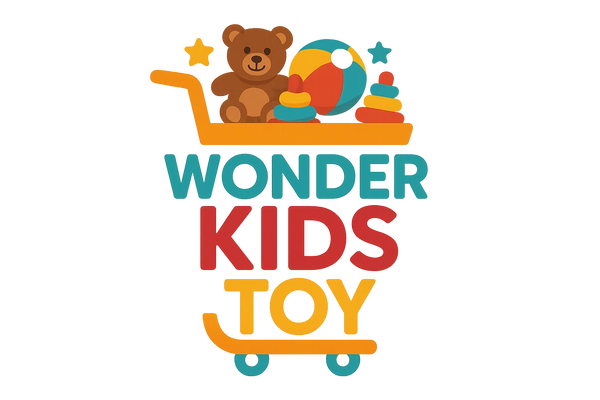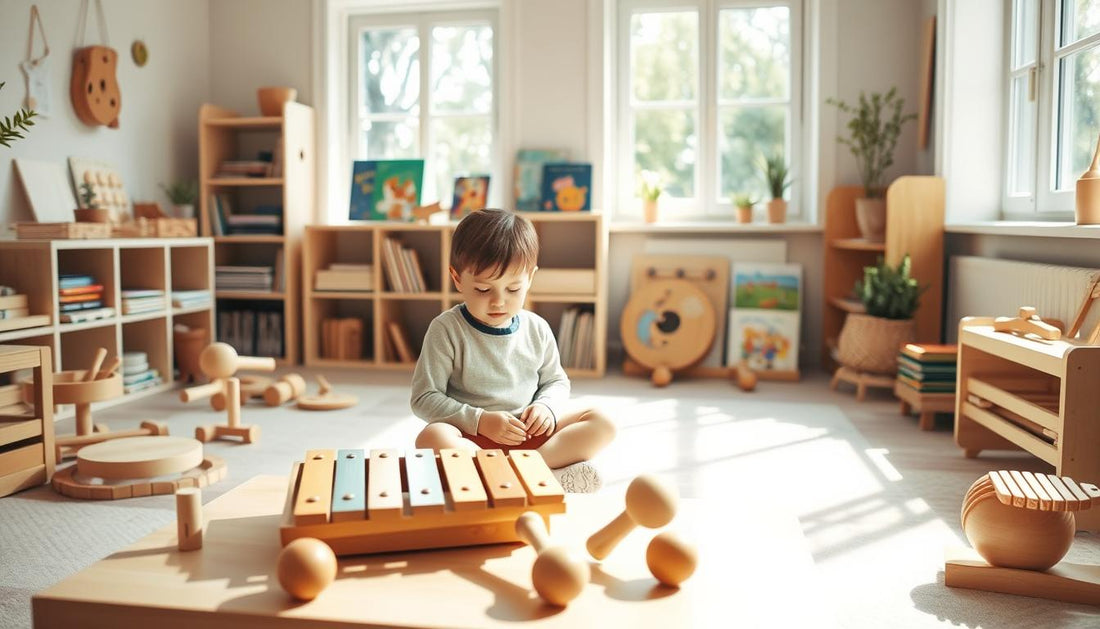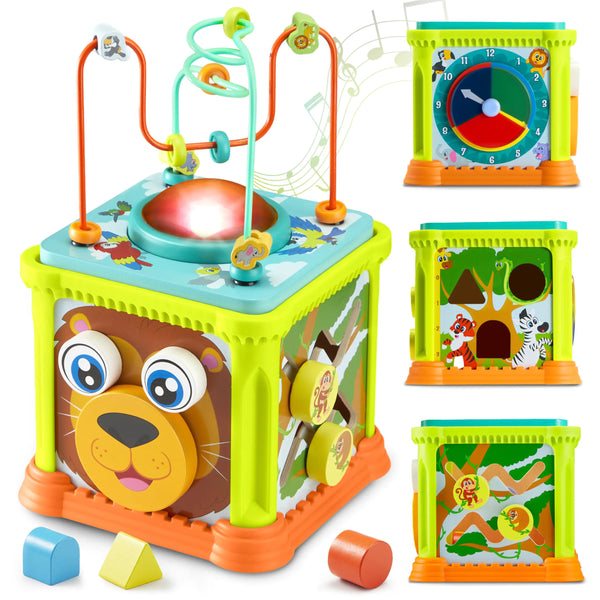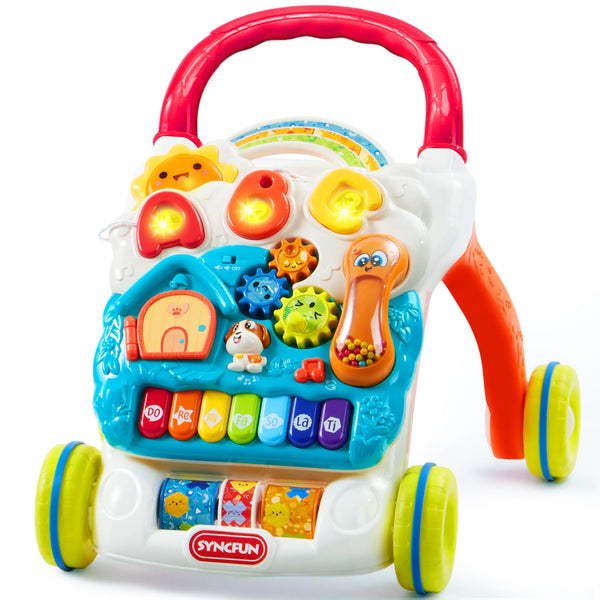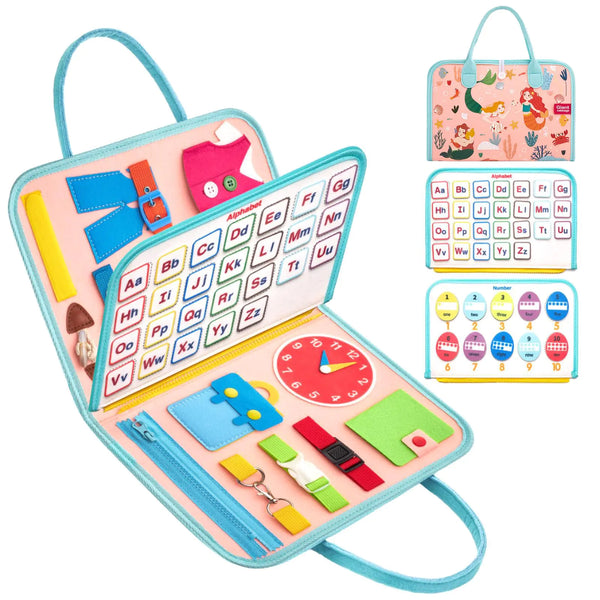Introducing music to my toddler has been a joy. It's all thanks to the Montessori methods. I've found that educational toys based on these principles help my child develop a lifelong love for music.
Music isn't just fun; it's great for growing brains. Studies show it boosts memory, language, and problem-solving skills. By incorporating music into my toddler's daily routine, I'm setting them up for success in many areas.
Montessori Toys are perfect for introducing music. They're made to spark curiosity and learning. This lets my toddler explore music at their speed.
Key Takeaways
- Early musical exposure enhances cognitive development in toddlers.
- Montessori methods encourage independent learning and exploration.
- Educational toys play a key role in introducing music to toddlers.
- Music education can improve memory, language skills, and spatial-temporal skills.
- Incorporating music into daily routines fosters a lifelong love of music.
What are Montessori Toys?
In my search for ways to spark my toddler's love for music, I found Montessori toys. They mix fun with learning. These toys help kids learn music on their own, making it a great way to start.
Overview of Montessori Principles
Dr. Maria Montessori created the Montessori method. It focuses on kids learning by themselves and playing together. Montessori materials are beautiful and made from natural materials, which makes kids want to play with them.
The Montessori way of teaching puts kids at the center. It prepares the environment for kids to learn and grow by themselves. This is great for music, letting kids explore sounds and rhythms at their speed.
Key Features of Montessori Toys
Montessori toys stand out because of their special features. These include:
- Promoting hands-on learning and exploration
- Being made from natural materials
- Encouraging independence and self-directed learning
- Fostering a deep understanding of concepts through practical application
For music, Montessori toys like xylophones, drums, and maracas are perfect. They're made from natural stuff and are safe and durable for little hands.
| Feature | Description | Benefit |
|---|---|---|
| Hands-on Learning | Montessori toys encourage children to learn by doing. | Develops fine motor skills and hand-eye coordination. |
| Natural Materials | Toys are made from natural materials like wood and cotton. | Provides a tactile experience and connects children with nature. |
| Independence | Toys are designed to be used independently. | Fosters self-confidence and self-directed learning. |
Knowing about Montessori toys helps parents choose the right educational tools. It sets a strong foundation for a lifelong love of music and learning.
The Importance of Music in Early Childhood

Music is key in early childhood education. It helps kids grow in many ways. As a parent, I've seen how music boosts my toddler's thinking and creativity.
Studies show music is great for young minds. It enhances their ability to remember things and learn new words.
"Music is a universal language that can bridge cultural and linguistic divides, making it an invaluable tool for early childhood education."
Benefits of Music for Development
Music is good for young kids in many ways. It helps with memory, language, and even fine motor skills. They learn to clap and dance.
| Cognitive Benefits | Motor Skills Benefits | Emotional Benefits |
|---|---|---|
| Improved memory | Enhanced fine motor skills | Better emotional regulation |
| Language development | Coordination and balance | Increased creativity |
How Music Encourages Creativity
Music lets kids express themselves freely. Through play-based learning with instruments and songs, my toddler's imagination grows.
Using sensory toys that make sounds is fun. Toys like xylophones or drums teach cause and effect. They entertain and educate.
Music makes my toddler curious and open to new things. It's a great start for their future creativity.
Choosing the Right Montessori Toys for Music

Montessori toys are more than just playthings. They are tools that help my child love music for life. When selecting the right Montessori toys for music, consider a few key factors. This ensures they meet my child's needs as they grow.
Factors to Consider
Material, sound quality, and durability are key when choosing Montessori toys. Wooden toys are great because they're not only good for the planet but also look nice. They also make sounds that are fun for my child to listen to. Plus, open-ended toys let my child be creative and try out different sounds and rhythms.
When checking the sound quality, I want toys that make clear, easy-to-hear sounds. This helps my child improve their listening skills. Toys need to last a long time, too, because Montessori toys are made to be durable and used a lot.
Popular Musical Montessori Toys
Some top Montessori toys for music are xylophones and drums. They're great for introducing my child to music. Xylophones have colorful bars and make different sounds, teaching my child about music. Drums help my child learn rhythm and timing.
Other toys worth mentioning are musical instruments like maracas and tambourines. They let my child be creative and have fun. These toys also help with fine motor skills and hand-eye coordination.
- Xylophones for teaching musical notes
- Drums for developing a sense of rhythm
- Maracas and tambourines for creative expression
Creating a Musical Environment at Home

My toddler's curiosity about music inspired me to create a musical environment. This environment fosters creativity and learning. I discovered that a dedicated musical space can greatly enhance my child's musical journey through Montessori toys.
To begin, I set up a music corner that's inviting and stimulating. I chose a quiet area of our home for my child to explore sounds without distractions. The space is filled with Montessori musical instruments and toys that encourage experimentation.
Setting Up a Music Corner
When setting up the music corner, I considered a few key factors. I made sure the area is easily accessible to my toddler. This lets them explore the instruments and toys on their own. I also organized the space well, with each item in its place.
This organization teaches my child about responsibility and order. The music corner has a variety of educational toys to introduce my child to musical concepts. These include xylophones, drums, and maracas, all safe for toddlers.
Choosing Instruments and Toys
Choosing the right instruments and toys was a thoughtful process. I picked instruments that are both fun and educational. For example, a Montessori xylophone helps my child understand melody and pitch.
A drum set introduces them to rhythm and timing. I also considered the durability and safety of the instruments. They are made from non-toxic materials and are sturdy for regular use. This way, I've created a musical environment that's engaging and enriching for my toddler.
Incorporating Rhythm into Playtime

Rhythm is key to a child's musical growth. There are easy ways to add it to playtime. By doing so, I help my toddler improve their timing and coordination.
Simple Activities to Encourage Rhythm
Clapping is a simple way to get the rhythm going. I can clap with my child, making simple beats for them to mimic. This not only boosts their rhythm but also strengthens our bond.
Using everyday items to make sounds is another fun activity. For instance, banging pots and pans or shaking a container with beads can spark their interest in rhythm.
Using Percussion Instruments
Percussion instruments are great educational toys for rhythm. Drums, maracas, and tambourines are not only enjoyable but also aid in musical development. I start with simple ones and add more complex ones as they grow.
These instruments let me create different rhythms for my child to follow. This interactive play helps them grasp rhythm and timing, setting a solid base for their musical journey.
Adding rhythm to playtime makes learning music fun and engaging for my child. With the right learning toys and activities, they can become musically aware.
Exploring Different Genres of Music

Introducing my toddler to many musical genres is key. This includes classical and folk music. The Montessori method helps us explore music deeply, laying a strong musical foundation.
Introducing Classical Music
Classical music is an excellent start. It has complex tunes and calming melodies. I use Montessori materials to make it fun for my child. For example, playing Mozart and Beethoven while they play with sensory toys creates a peaceful atmosphere.
Fun with Folk Songs
Folk songs are a hit with my toddler. They're simple, catchy, and easy to sing along to. I mix action songs and storytelling with folk music to make learning fun.
| Genre | Characteristics | Montessori Activities |
|---|---|---|
| Classical | Complex, soothing | Playing composer recordings with sensory toys |
| Folk | Simple, catchy | Action songs, storytelling |
By exploring various music genres, my toddler's musical tastes grow. This not only deepens their musical knowledge but also boosts their creativity and cultural appreciation.
Encouraging Active Participation in Music

Music becomes more fun when my toddler joins in. The Montessori method emphasizes the importance of getting kids involved in music. This helps them grow.
Singing Together
Singing together is a great way to get kids involved in music. My toddler loves making sounds and learning new words. Singing songs with actions makes it even more fun.
Using wooden toys that resemble instruments, such as xylophones or drums, is also beneficial. These toys are tough and fit with the Montessori idea of using natural materials.
Creating Simple Dance Routines
Creating simple dance moves to songs is another fun way to get kids moving. My toddler loves dancing and copying me. It's a fun mix of music and movement.
To make it even better, I sometimes add props like scarves or ribbons. These add a fun visual part to the dance.
| Activity | Benefits | Montessori Alignment |
|---|---|---|
| Singing Together | Develops language skills, encourages bonding | Promotes auditory development, fosters creativity |
| Creating Dance Routines | Enhances physical coordination, encourages creativity | Supports physical development, encourages self-expression |
| Using Wooden Musical Toys | Introduces musical concepts, develops fine motor skills | Aligns with natural material preference, promotes play-based learning |
Adding these activities to our daily life has really helped my toddler enjoy music more. It's not just listening; it's about having fun and learning together.
Connecting Music with Other Learning Areas

Connecting music to other learning areas can enrich a child's education. The Montessori method is excellent for this because it focuses on learning connections.
Music is a powerful tool for improving many skills. For example, it helps a lot with language skills. Studies show that music training boosts phonological awareness, which is key to reading and writing.
Music and Language Development
Singing songs and reciting nursery rhymes help kids get the rhythm of language. Montessori methods use open-ended toys to encourage creative music and language play.
Using instruments during stories makes the experience more fun and interactive. This helps kids improve their language skills and grow to love music.
Music and Fine Motor Skills
Playing musical instruments, like the piano or drums, can significantly improve fine motor skills. Eco-friendly toys, such as wooden xylophones or maracas, are not only great for music exploration but also good for the planet.
| Activity | Fine Motor Skill Development | Language Development |
|---|---|---|
| Playing the Xylophone | Improves hand-eye coordination and finger dexterity | Enhances phonological awareness through sound recognition |
| Clapping to a Beat | Develops timing and rhythm through physical movement | Encourages auditory discrimination and language rhythm |
| Singing Nursery Rhymes | Enhances vocal control and expression | Fosters linguistic skills and vocabulary building |
By mixing music with other learning areas, parents can create a rich learning environment. This not only aids in development but also makes learning both fun and engaging.
DIY Montessori Music Projects

I love introducing my toddler to music with DIY Montessori projects. These activities are both fun and educational. They help foster a love for music, boost creativity, and improve fine motor skills.
Crafting Homemade Instruments
Making homemade instruments is a great way to introduce music to my toddler. One easy project is making a shaker instrument. We fill empty plastic bottles with rice, beans, or small pebbles. Then, my toddler shakes them to the beat of our favorite songs.
We can also make a drum from a metal or plastic container and a wooden spoon or drumstick.
Steps to Make a Simple Drum:
- Find a clean, dry container with a lid (like a coffee can or large tin).
- Decorate the container with paint, stickers, or colorful tape.
- Use a wooden spoon or a drumstick to create sounds.
Fun Music-Themed Sensory Bins
Music-themed sensory bins are another fun DIY project. We fill a bin with materials that make different sounds or textures. This includes sand, rice, or beans. We hide small instruments or music-related items, such as drumsticks or maracas. This activity encourages exploration and creativity.
| Sensory Bin Theme | Materials | Activity |
|---|---|---|
| Beachy Music | Sand, small shells, tiny maracas | Hide the maracas and have my toddler dig them out. |
| Rice Rhapsody | Rice, small drums or shakers | Have my toddler pour rice into containers to create sound. |
By doing these DIY Montessori music projects, I'm teaching my toddler about music. I'm also teaching them about creativity, experimentation, and the joy of making something with our own hands.
Hosting Musical Playdates

Hosting musical playdates for my child boosts their musical skills and helps them make friends. It's a great way to mix fun with learning. By gathering kids who love music, we create a space for both fun and growth.
Ideas for Musical Gatherings
When planning musical playdates, I pick activities that are fun, interactive, and simple for kids. Some ideas include:
- Simple instrument play
- Musical storytelling
- Freeze dance
- Sing-alongs with actions
These activities keep kids entertained and encourage them to join in. It's a fun way to learn music together.
Collaborative Music Activities
Montessori methods stress the value of working together. At musical playdates, we do activities that teach teamwork and cooperation, like:
| Activity | Description | Learning Outcome |
|---|---|---|
| Group Instrument Play | Children play simple instruments together following a rhythm or beat. | Develops teamwork and timing skills. |
| Musical Mosaic | Children create a musical piece together, each contributing a sound or rhythm. | Enhances creativity and collaboration. |
By hosting musical playdates and focusing on teamwork, I give my child a great place for play-based learning and making friends. It's a way to grow their love for music and learn essential life skills.
Using Technology to Enhance Musical Learning

I've found that technology can make learning music fun for my toddler. The right tools make music interactive and engaging.
"Music is the divine way to tell beautiful, poetic things to the heart." - Pablo Casals. This quote makes me think of my child enjoying music on digital platforms.
Recommended Apps for Young Children
Many apps help young children learn music. Some of my top picks are:
- Musical apps with games and activities, like Songify and Musical Touches.
- Apps for making music, such as Magical Piano and Drum Pad Machine.
Online Resources for Montessori Music
There are also online resources for Montessori music. Some great websites include:
- Those with Montessori-inspired music lessons and activities.
- Websites with a wide range of children's music, including lullabies and nursery rhymes.
These resources help me give my child a well-rounded musical education, following Montessori principles.
Using technology, I can offer a rich and engaging musical education for my toddler. It sets the stage for a lifelong love of music.
Observing My Toddler's Musical Preferences

By paying attention to my toddler's responses to music, I can tailor our musical experiences to their needs. This approach not only enhances their musical development but also fosters a deeper connection between us.
Signs of Musical Interest
My toddler shows musical interest in various ways, such as clapping along to a rhythm or attempting to sing along with simple songs. These signs indicate that they are beginning to understand and engage with music on a fundamental level. They are drawn to educational toys that produce musical sounds, which encourages them to explore and learn.
Some common signs of musical interest in toddlers include:
- Making sounds or babbling in rhythm
- Clapping or moving their body to music
- Showing interest in musical instruments or toys
Adapting to Changing Tastes
As my toddler grows, their musical tastes and interests evolve. It's essential to be observant and adapt our approach to their changing preferences. For instance, if they show a keen interest in a particular type of music or instrument, I incorporate more of that into our playtime. This might involve introducing open-ended toys like xylophones or drums that allow them to experiment and create their music.
By being responsive to their changing tastes, I can keep our musical experiences engaging and fun. This not only supports their musical development but also encourages a lifelong appreciation for music.
Expanding Musical Knowledge as They Grow

As my child grows, I want to introduce them to the rich world of music history and different cultures. Montessori methods help them learn and appreciate music more. This way, they gain a deeper understanding of the diverse world of music.
One way to do this is by introducing music history in a fun and interactive way. Montessori suggests using stories and visual aids to make history come alive.
Introducing Music History
I start by sharing stories about famous composers and musicians. For example, I tell the story of Mozart. I explain how he began composing at a young age and went on to create iconic pieces.
This not only teaches my child about music history but also inspires them to explore different genres. I make learning fun by incorporating hands-on activities, such as crafting timelines or creating a "composer of the month" project. These activities help them see how music has evolved.
Exploring Different Cultures through Music
Exploring different cultures through music is also key. Montessori methods encourage learning about music from various cultures. This broadens their musical understanding and appreciation.
I introduce my child to traditional instruments and songs from around the world. We learn about the cultural significance of instruments like the sitar from India or the djembe from Africa. This enriches their musical knowledge and promotes cultural awareness.
By incorporating music from different cultures into our daily routine, we create a diverse musical environment. This encourages exploration and appreciation. It helps my child develop a nuanced understanding of the world's musical heritage and fosters a lifelong love for music.
Fostering a Lifelong Love for Music

Teaching my toddler to love music is a top goal. Montessori methods are key in this journey. By using Montessori Toys during play, we create a space for musical discovery and creativity.
Encouraging Exploration and Experimentation
Montessori focuses on letting kids learn at their own pace. In music, this means giving them Montessori Toys to play with. Simple instruments like xylophones and drums are great for little hands to make music.
Letting my toddler play with these instruments teaches them about music. It also helps them feel independent and creative. This play-based learning way helps my child love music deeply, not just play it.
Sharing My Musical Journey with My Toddler
As a parent, I get to share my love for music with my toddler. Singing, going to concerts, or dancing at home shows them music's place in life. This strengthens our bond and teaches my child to love music for joy and connection.
Sharing my musical journey also teaches my child to love learning and exploring. Exploring different music styles together shows them there's always more to discover. This Montessori mindset will help my child throughout their life.
Tips for Parents on Incorporating Music Daily
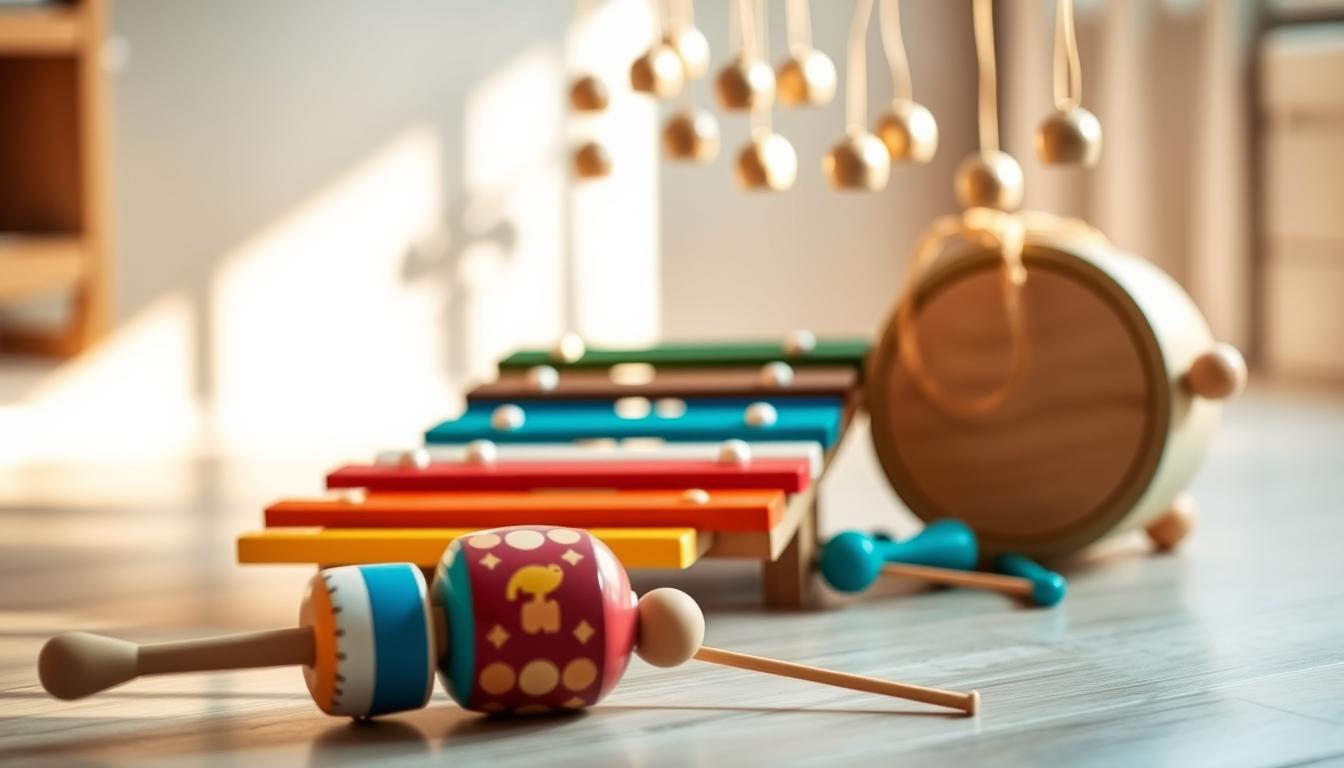
Music is now a big part of our daily lives. I've found easy ways to add it to our routine. Making music a daily habit has helped my child grow and made our family happier.
Simple Daily Routines
Adding music to our daily tasks is easy. For instance, singing nursery rhymes while doing laundry or cooking makes these chores fun for my child.
Here are some ways to make daily routines more musical:
- Singing songs during bath time
- Playing musical instruments during playtime
- Creating a daily playlist for car rides
Making Music a Family Activity
Montessori methods stress the value of making music a family affair. When we all join in, it makes music time more fun and engaging. This helps our kids develop a greater love for music.
Here are some ideas to make music a family activity:
| Activity | Description | Benefits |
|---|---|---|
| Family Dance Parties | Put on some music and have a dance party together | Encourages bonding and physical activity |
| Playing Instruments Together | Choose simple instruments and play together | Develops fine motor skills and teamwork |
| Singing Together | Choose your favorite songs and sing together | Enhances language development and family bonding |
By incorporating music into our daily lives and turning it into a family activity, we can instill a lifelong love of music in our kids. Using sensory toys and wooden toys that encourage musical exploration can make this experience even better.
Reflecting on Our Musical Adventures
Looking back, I'm amazed at how much my toddler has grown. We've used Montessori materials and educational toys to create a world of music. This world encourages creativity and exploration.
I've learned to be a guide, not just a teacher. By giving the right tools and support, my child has grown to love music. It's more than just playing.
Lessons Learned
One key lesson is to pay attention to what my child enjoys in music. This helps us pick the right toys and experiences for them. It makes our music time memorable and meaningful.
Future Music Goals
Now, we're looking forward to even more musical adventures. We'll introduce new instruments and ideas using Montessori methods. This will make our journey even more exciting with a variety of materials.
FAQ
What are Montessori toys, and how do they relate to music education?
Montessori toys help kids learn on their own and through hands-on activities. They introduce music to toddlers through fun, interactive ways. This includes playing with xylophones and drums made from wood.
Why is music important in early childhood development?
Music boosts brain growth, creativity, and fine motor skills in young kids. Montessori education incorporates music to help children develop a lifelong love of music and grow well.
How do I choose the right Montessori toys for music education?
Pick toys based on your child's age and the material. Look for eco-friendly options like xylophones, drums, and maracas. They help kids explore music.
How can I create a musical environment at home using Montessori toys?
Set up a music corner with various instruments and toys. Choose items that encourage kids to explore music through play.
What are some simple activities to encourage rhythm in my toddler?
Try clapping, tapping, and using drums and maracas. Montessori suggests adding rhythm to playtime to help kids develop timing.
How can I introduce different genres of music to my toddler?
Explore various music styles, including classical and folk. Make it fun by singing, dancing, and using open-ended toys.
How can I encourage my toddler to participate actively in music?
Sing together, dance, and make music with your child. Montessori makes music a fun, collaborative activity.
Can music be connected to other learning areas, like language development?
Yes, music can help with language and fine motor skills. Montessori uses music to support these areas, such as through song lyrics and playing instruments.
What are some DIY Montessori music projects I can try with my toddler?
Make homemade instruments or music-themed sensory bins. These projects spark creativity and musical exploration.
How can I use technology to enhance musical learning for my toddler?
Use apps and online tools that support Montessori music education. They offer games and tools for musical learning.
How do I observe my toddler's musical preferences and adapt to their changing tastes?
Watch how your child reacts to different music and instruments. Adapt your approach as their tastes evolve. Montessori suggests following their interests in music.
How can I expand my child's musical knowledge as they grow?
Introduce music history and explore different cultures through music. Engage in more complex activities as your child grows. Montessori helps deepen music understanding over time.
What are some tips for incorporating music into daily routines?
Sing during chores, play music at meals, or have a daily dance party. Montessori makes music a natural part of daily life.
How can I reflect on our musical adventures and set future music goals?
Note what works and what doesn't in your musical experiences. Set new goals by exploring new instruments or genres. Use Montessori methods to guide your approach.

